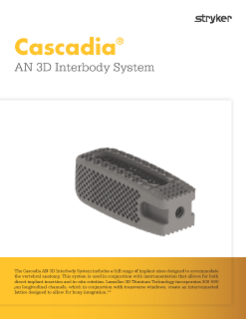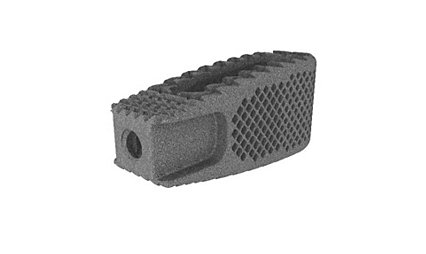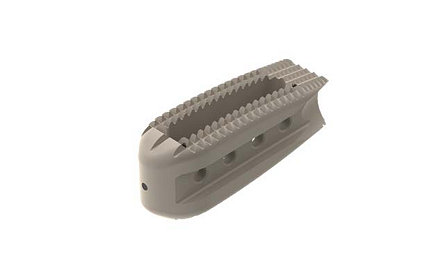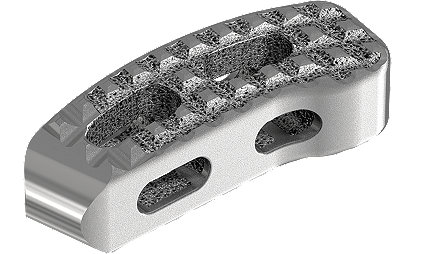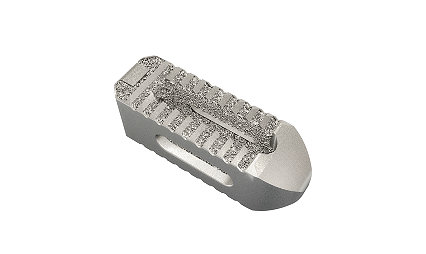Cascadia AN 3D
Interbody System
The Cascadia AN 3D Interbody System includes a full range of implant sizes carefully designed to accommodate the vertebral anatomy. This system is used in conjunction with instrumentation that allows for both direct implant insertion and in-situ rotation. Lamellar 3D Titanium Technology incorporates 300-500 um longitudinal channels, which in conjunction with transverse windows can create an interconnected lattice designed to allow for bony integration. [1,2]
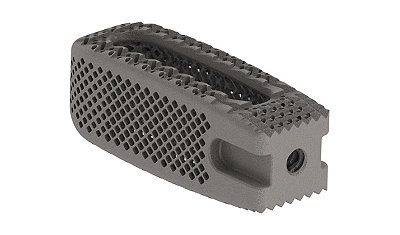
Main Features
- Roughened titanium surfaces have been shown to demonstrate increased protein expression in contrast to smooth titanium surfaces [3,4,5]
- Lamellar 3D titanium interbody with approximately 70% porosity [1]
- Reverse hourglass design allows for a large graft volume [1]
- Bulleted nose to ease insertion [1]
- 3-5 μm surface roughness to allow for direct bony ongrowth [1,2]
References:
1. Test Report TR-1220.
2. Loh QL and Choong C. “Three-dimensional scaffolds for tissue-engineering applications: Role of porosity and pore size.” Tissue Engineering Part B 19 (230):1 485-502.
3. Karande TS, Kaufmann JM, and Agrawal CM. “Chapter 3: Functions and Requirements of Synthetic Scaffolds in Tissue Engineering.” Nanotechnology and RegenerativeEngineering: The Scaffold, Second Edition. Ed. CT Laurencin and LS Nair. Boca Raton: CRC Press, 2014. Pages 63-102.
4. Bobyn JD, Pilliar RM, Cameron HU, and Weatherly GC. “The optimum pore size for the fixation of porous-surfaced metal implants by the ingrowth of bone.” ClinicalOrthopaedics and Related Research 150 (1980): 263-270.
5. Karageorgiou V and Kaplan D. “Porosity of 3D biomaterials scaffolds and osteogenesis.” Biomaterials 26 (2005): 5474-5491.
Related products
Cascadia AN Lordotic 3D
The Cascadia AN Lordotic 3D Interbody System includes a full range of anatomically designed interbodies for multiple spinal applications. This system aims to assist in the restoration and maintenance of disc height and sagittal balance in the lumbar spine. Lamellar 3D Titanium Technology incorporates 300-500 μm longitudinal channels, which in conjunction with transverse windows can create an interconnected lattice designed to allow for bony integration. [1,2]
Learn moreCascadia AN Lordotic-Oblique 3D
The Cascadia AN Lordotic-Oblique 3D Interbody System includes a full range of anatomically designed interbodies for multiple spinal applications. This system is designed to offer a comprehensive solution for the restoration and maintenance of disc height to facilitate sagittal balance in the lumbar spine. Lamellar 3D Titanium Technology incorporates 300-500 μm longitudinal channels, which in conjunction with transverse windows can create an interconnected lattice designed to allow for bony integration. [1,2]
Learn moreAleutian Anatomically-Narrow Lordotic
The Aleutian Anatomically-Narrow (AN) Lordotic Interbody System has a full range of anatomically-designed PEEK interbodies for multiple spinal applications. The system is designed to offer a comprehensive solution to help achieve sagittal balance in the lumbar spine.
Learn moreTritanium TL
A hollow implant that consists of a configuration of both solid and porous structures built using AMagine Technology, our proprietary approach to implant creation using additive manufacturing. This cage is available in a variety of heights, lengths and lordotic angles to accommodate various patient anatomies. Tritanium TL's Anterior Placement System and cage design combine to enable the surgeon's desired apophyseal placement. Tritanium TL complements Tritanium PL, and together they offer alternative posterior lumbar solutions.
Learn moreTritanium PL
A hollow, rectangular implant that consists of a configuration of both solid and porous structures built using AMagine Technology, our proprietary approach to implant creation using additive manufacturing. This cage is available in a variety of widths, lengths, heights, and lordotic angles to accommodate a variety of patient anatomies. It features a large, open graft window as well as a smooth wedge nose to facilitate insertion into the disc space. A threaded inserter connection is designed to promote rigid connectivity and control during insertion.
Learn moreThis document is intended solely for the use of healthcare professionals. The products depicted are in accordance with applicable Regulations and Directives.
Please find our full product disclaimer here.
PRTTL-WB-36_31045

